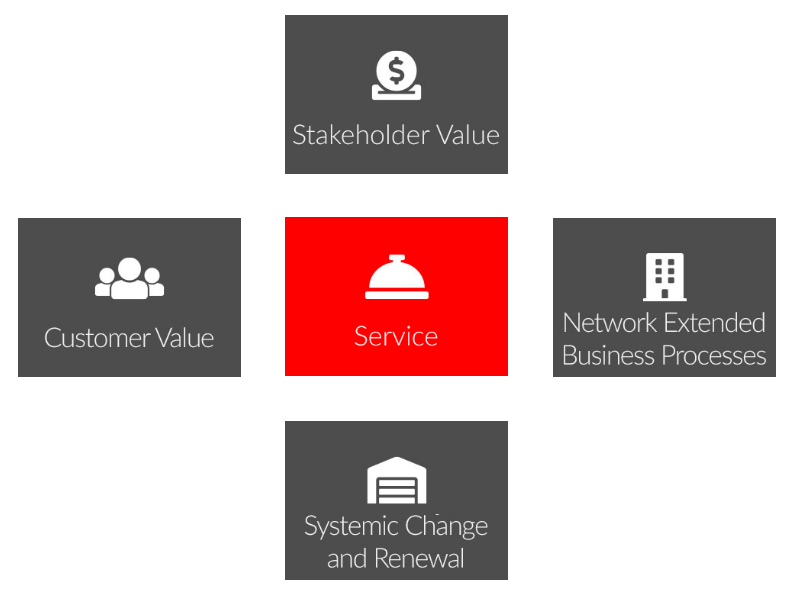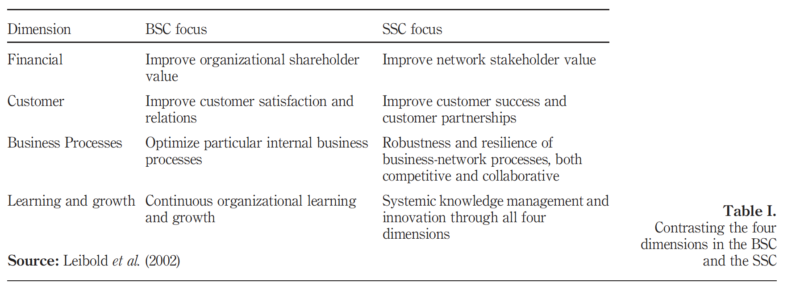The stakeholder value perspective gathers information about the financial and non-financial value added for stakeholders. The traditional shareholder value is subsumed into this view. As part of the business eco-system, the firm should also aim to get an insight into the value objectives of their stakeholders and whether these objectives are met. The community can be included into this view as well as employees, suppliers and other organizations. By closely keeping in touch with the co-evolving environment, firms can not only work more efficiently, but more effectively as well. Such collaborations as practiced by DaimlerChrysler and GM in
entering the market of hybrid gas-electric automobiles together, joining forces in development, show the significance of such models even between competitors. In this case the two industry giants emphasized the gains in time-to-market and costs to face the competition by early-tomarket leaders Toyota and Honda. The embeddedness into the socio-cultural system supports, instead of impedes, dynamic change initiatives to move the company forward. Moreover, it can be used as a tool for monitoring and making sense of the business environment. The knowledge gained here can respectively be used as valuable information for
evaluating innovation, answering the question of whether to develop ideas into a product or rather externalize them.
(Voepel et al, 2006)
- Voelpel et al. , “The tyranny of the Balanced Scorecard in the innovation economy,” Journal of Intellectual Capital , Vol. 7 No. 1, 2006, pp. 43‐60
Within the customer value perspective, companies look at their capability to constantly provide new customer value. In contrast to the BSC, the main focus of this view should be shifted from the mere goal to deliver simply more value than others, to trying to co-create new value for customers in the business ecosystem. The creation of not only the same value in improved ways, but the ability to find ways in which value can be created differently on a regular basis is a decisive ability. By finding different ways to address customer needs new markets can be created and unrealized potential can be harnessed. It is a shift from delivering a better product in comparison to others to delivering a product that really addresses the needs of the customer, including those that the customer may not even know him- or herself yet. Customer knowledge management for instance can help to achieve such new and heightened customer value improvements. Amazon.com serves as an example of a firm that manages customer knowledge successfully through customer book reviews, individual order histories and customized suggestions for other books. In another instance Netscape published the source code of its internet browser, externalizing development to an open source project, which challenges market leader Microsoft. profiting from its customers, Netscape then incorporated the knowledge and innovation gained from its open source software into the new Netscape version that is soon to re-enter the market with an improved product.
(Voepel et al, 2006)
- Voelpel et al. , “The tyranny of the Balanced Scorecard in the innovation economy,” Journal of Intellectual Capital , Vol. 7 No. 1, 2006, pp. 43‐60
All costumers value, stakeholders value, systemic change/ renewals and networked extended business are collected through services (or products) in the business eco-system.
In contrast to the BSC, the main focus of this view should be shifted from the mere goal to deliver simply more value than others, to trying to co-create new value for customers in the business ecosystem. The creation of not only the same
value in improved ways, but the ability to find ways in which value can be created differently on a regular basis is a decisive ability. By finding different ways to address customer needs new markets can be created and unrealized potential can be harnessed. It is a shift from delivering a better product or service in comparison to others to delivering a product that really addresses the needs of the customer.
In the networked extended business processes view, companies focus on creating,
maintaining and fostering business networks and their processes. Since today’s business operations are not carried out anymore in a vacuum until the final product is delivered, but accompanied by constant stakeholder interaction, feedback and exchange, the former business processes perspective introduced by the BSC needs to be extended to include these networks, both competitive and collaborative. The evaluation of this view may take into account how many networks exist, their perceived potential and usefulness, as well as their quality, by reviewing members’ experience and success within interviews or questionnaires.
(Voepel et al, 2006)
- Voelpel et al. , “The tyranny of the Balanced Scorecard in the innovation economy,” Journal of Intellectual Capital , Vol. 7 No. 1, 2006, pp. 43‐60
The systemic knowledge and renewal dimension is the extension of the innovation and learning perspective known from the BSC. In contrast to the internally focused learning and growth perspective of the BSC, this systemic dimension acknowledges the potential of the entire system. In order to track networked innovation processes in addition to “time to market” measures, to percent of (sales from) new products and other indicators, the systemic view should include all knowledge involved in the process of innovation. It needs to become a cross-section through all business areas that transcends the traditional focus on the R&D department. All knowledge in this case means that not only the financial outcomes of marketed products are measured, but that knowledge is assessed in all its developing stages, if possible from the surfacing of the idea to the death of a product or service that is finally taken from the market. (Voepel et al, 2006)
- Voelpel et al. , “The tyranny of the Balanced Scorecard in the innovation economy,” Journal of Intellectual Capital , Vol. 7 No. 1, 2006, pp. 43‐60


